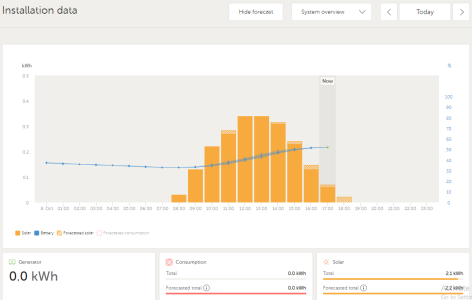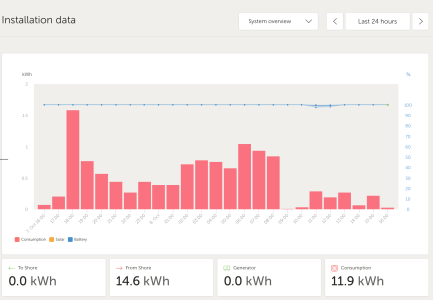Forty_Two
Well-Known Member
Multiplus has a "forced absorption" mode which stops it going to float. Check your manual. I have a remote panel & it's done by flicking the toggle switch several times in a few seconds.
so looks like batteries were almost empty, there's no way the 97% is accurate if it's dumping 80A now
No BMV, but SmartShunt via Bluetooth and VE Connect to a Cerbo (with screen) then up to VRM.so looks like batteries were almost empty, there's no way the 97% is accurate if it's dumping 80A now
push charge them, the counter resets, you should be fine I recon.
simply having changed to lifepo4 now for 3+ yrs I know % are accurate as they come from the bms and not what and how the multi is configured.
have you also got a BMV? (the round monitor thing and shunt)
In my experience with shunts and lead batteries, it's not easy keeping the shunt set such that it gives any meanngful results. I know a few people who have had battery issues because they assumed their shunt was telling the truth. When in doubt, a full 7 to 8 hours charge to get full is what is needed, assuming you have the charging capacity.No BMV, but SmartShunt via Bluetooth and VE Connect to a Cerbo (with screen) then up to VRM.
Helpful, thanks. The problem I have come up against is getting the charger to run a recharge process like that, another poster says there is a forced Abs phase facility, I’ll need to research that.In my experience with shunts and lead batteries, it's not easy keeping the shunt set such that it gives any meanngful results. I know a few people who have had battery issues because they assumed their shunt was telling the truth. When in doubt, a full 7 to 8 hours charge to get full is what is needed, assuming you have the charging capacity.
If you have lots of charge capacity you may find you go from bulk to absorbtion within a couple of hours but you should see an absorbtion phase correspondingly long. The combined bulk and absorbtion phase should be circa 7 hours for AGM batteries to get a full charge. If you know the batteries are depleted, this is the time period you will see from starting bulk to hitting float. This is often not understood.
Different chargers have different criteria for switching from Absorption to float.In my experience with shunts and lead batteries, it's not easy keeping the shunt set such that it gives any meanngful results. I know a few people who have had battery issues because they assumed their shunt was telling the truth. When in doubt, a full 7 to 8 hours charge to get full is what is needed, assuming you have the charging capacity.
If you have lots of charge capacity you may find you go from bulk to absorbtion within a couple of hours but you should see an absorbtion phase correspondingly long. The combined bulk and absorbtion phase should be circa 7 hours for AGM batteries to get a full charge. If you know the batteries are depleted, this is the time period you will see from starting bulk to hitting float. This is often not understood.
It makes anchors and anchoring seem like child’s play!Different chargers have different criteria for switching from Absorption to float.
Different battery manufacturers recommend different things.
Very often it boils down (no pun intended) to estimating when the battery is 95% or so full.
This can be when the current drops to a certain level, a time or something more 'smart'.
If the batteries have developed a self discharge habit, then this guesstimate may be wrong.
Or if they've lost capacity, then the absorption current may have shrunk too.
Hence some basic tests which are easy to understand can help.
Also some batteries have 'memory' to some extent, you need to give measurements time to settle.
A nice crude test drawing 5 or 10 A for some hours and watching the volts from time to time gives data that's hard to argue with.
To start with, we don't need precision here, we want to know has this battery still got useful capacity or not?
Sometimes a battery that seems hard to get fully charged will turn out to have lost a lot of capacity, like it's down to 25% of its original Ah or something. Then it's no wonder that its voltages are a bit off and the finer data are a little confusing.
Going into float when there's over 15A going in is just wrong in my book.At about 14.00 the charger went to float having been charging at 20A in Absorption. At 14.50 I put the charger in to forced Absorption but it dropped down to Float again about 15m later. I’ve again put it in to forced Absorption and waiting to see if it’ll drop down to float again.
View attachment 183983
agree!Going into float when there's over 15A going in is just wrong in my book.
can we also have the system overview graph with the kWh for today?At about 14.00 the charger went to float having been charging at 20A in Absorption. At 14.50 I put the charger in to forced Absorption but it dropped down to Float again about 15m later. I’ve again put it in to forced Absorption and waiting to see if it’ll drop down to float again.
View attachment 183983

Not sure if this is helpful but here it is:can we also have the system overview graph with the kWh for today?
like this:
View attachment 183987

not particularly helpful tbh...
Yes, onboard, dehumidifier and heating.not particularly helpful tbh...
14.6kWh from shore (rather lot!) and 11.9kWh consumption? are you onboard? cooking, air-con heating?
Victron kit is programmable. There are recommendations on how to charge batteries by the manufacturers. Setting up the correct charging regime is important to ensure good battery life. If you have a charger prematurely switching to float, you have the wrong charger or the wrong settings.Different chargers have different criteria for switching from Absorption to float.
Yes, it's clever. Lot's of people know what it does. Some people will obviously use different settings, that's the whole point of the using customisable equipment. Most/all of the modern equipment gets automatically updated anytime it's connected to the Victron software.That's the problem with all this Victron kit, it's too clever, nobody knows what it's really doing, everybody is using different settings if not a different edition of the software.
How do you think your little charge would work for the OP ?My little CTek charger does some odd things if you look closely with a scope, but it seems to get to the right place ~eventually~.
If you don't do something you're not going to get anywhere. How have you jumped to the "duff battery" ? What charger settings are you using ? How are you setting the Multi settings ?I’m surprised by the need to do all of the above and to find now that the Multi has not been keeping the batteries properly charged. I had just about the same system on my previous boat (albeit that the Multi was an EasyPlus) and it looked after itself quite happily for sixteen years, it really was plug and forget, so I hope that once I can replace the duff battery this settles down and becomes as good as the old system. I don’t mind poking my head under the bonnet but I’d rather be sailing!